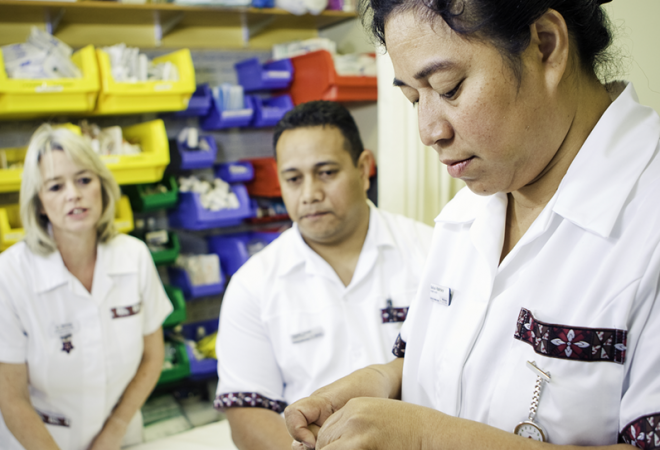
Student Nurses Exposure to Primary Health Care Nursing: Issues and Innovations
Status
Completed: 31 March 2012
Project Details
A project, completed in 2012, to provide an overview of current primary health care (PHC) clinical placements throughout New Zealand and identify barriers to, and opportunities for, providing PHC placements. A collaboration of Nurse Maude Association, New Zealand Institute of Community Heath Care and Christchurch Polytechnic Institute of Technology.
Aims:
The project aims were to:
- gather baseline information on the range of Primary Health Care (PHC) and community settings used in offering clinical experience to Bachelor of Nursing (BN) students
- identify barriers to providing quality PHC and community clinical placements
- identify areas of innovation in providing PHC and community placements
- make recommendations for ensuring BN students gain appropriate exposure to PHC and community-based nursing.
Methodology:
The project consisted of two components:
- a review of the international literature surrounding the issue of clinical placement provision for undergraduate health care professionals
- a questionnaire survey distributed to all universities and polytechnics (17) that offer BN programmes to capture both quantitative and qualitative data.
Team

Karen Betony
Project Leader
Nurse Maude Association
Judy Yarwood
Christchurch Polytechnic Institute of Technology (now ARA Institute of Canterbury)
Dr Chris Hendry
New Zealand Institute of Community Health Care
Dr Philippa Seaton
Christchurch Polytechnic Institute of Technology (now ARA Institute of Canterbury)Status
Funding
$9,730.00 (excl GST)
Key Findings
The key findings from the project included:
- The majority of Bachelor of Nursing (BN) Programme providers offer two Primary Health Care (PHC) and community placements, including one in the third year.
- Public health nurses, district nurses, Māori health providers and practice nurses were most widely used for PHC and community placement experiences. Providers used a creative range of nursing teams for PHC and community placements.
- Theoretical components of the programme relating to PHC and community were largely delivered as a discrete module though some providers also embedded the PHC components throughout. PHC specific clinical skills were taught by most providers.
- The PHC content was generally taught by a combination of academic staff with PHC experience or background, together with current clinicians, that is, staff working in PHC clinical settings. Clinical lecturers usually also had a PHC background.
- Key issues arising related to placement availability for increasing student numbers; the impact on staff taking a student and ensuring the PHC placements provided were valued.
- The majority of respondents felt their programmes prepared students for work in PHC, with the remainder (two) undecided.
- A revised curriculum to embed PHC concepts of health promotion and education throughout the programme and incorporating rest homes in the year three PHC placement to increase placement capacity.
- Only third year students who have identified an interest in PHC have a PHC placement for the Transition to Practice placement and then on to a new graduate programme. This ensures appropriate use of placements and helping the transition into a new role.
- A hospital admission reduction pilot project team will be approached to offer PHC placements.
- Establishing a Dedicated Education Unit in District nursing services has increased placement capacity, staff feel less pressured when students are on placement and students feel well supported.
- The advent of Whanau Ora may well lead to opportunities for integrating this programme into PHC placements enabling students to work with families.
Key Recommendations
The project recommendations were:
Establish regional clinical placement allocation groups | Establish regional clinical placement allocation groups to adopt a regional, rather than institutional approach to managing clinical placements.
Review funding regime | Review funding regime for clinical placements for nursing students particularly in PHC settings.
Increase inter-professional collaboration | Increased inter-professional collaboration could reduce competition for placements and open up opportunities for inter-professional placements, such as nurses with physiotherapists, and medical students with nurses.
Take a team approach | Take a team approach to student learning to include PHC teams such as dieticians, podiatrists and social workers, provided a Registered Nurse retains overall responsibility for supervising and assessing the student.
Clarification of core expectations | Clarification from the Nursing Council of New Zealand of the core expectations of a 'primary health care and community experience'. |
Further research | Further research to identify an appropriate exposure to theoretical, practical and clinical experience of PHC would reduce inconsistencies across the country and ensure students are prepared for work in PHC.
Ongoing collaboration | Ongoing collaboration between tertiary and healthcare providers is required together with further research to ensure PHC providers believe student nurses are suitably prepared for working in a PHC setting on qualifying.
A summary report prepared by Karen Betony, Judy Yarwood, Chris Hendry and Philippa Seaton.
(PDF, 217 KB, 6-pages).
- 31 March 2012